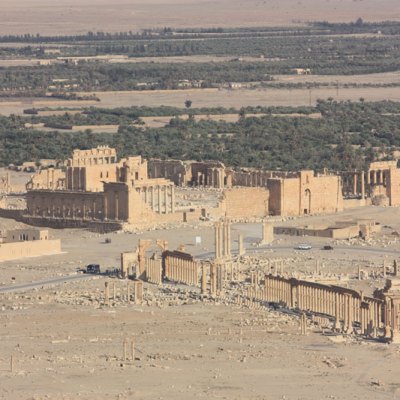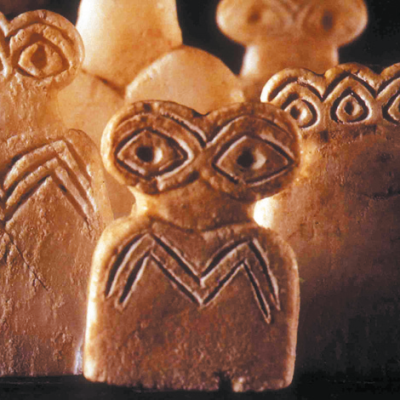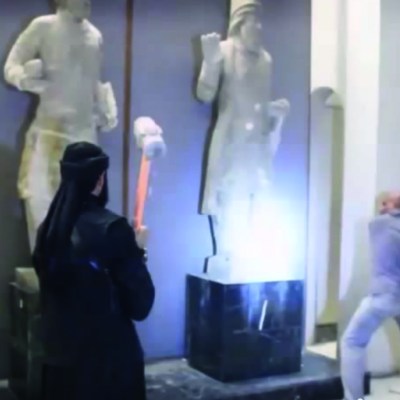This article was first published on The Spectator’s Culture House blog
Erudite and bespectacled, he was the sort of Arab the Islamic State loathed. Khaled al-Asaad, an 81-year old archaeologist, was for the past four decades inseparable from Palmyra’s ancient ruins.
Beheaded in part for his role shielding them from the militants, they strung his headless body up on Graeco-Roman columns he once restored. His remains dangle there still.
On the coat-tails of a pornography of violence which saw the immolation of a captured pilot and the sexual enslavement of a captured aid worker before her murder, Isis still found, somehow, a way to shock.
Four army lorries left Palmyra for Damascus the night before the town fell, evacuating as many objects as possible from its museum, says his friend Dr Abd al-Razzaq Moaz, Syria’s deputy culture minister from 2000 to 2007 and former director of its antiquities and museums. Mr al-Asaad assisted.
‘He had a vast knowledge about Palmyra and its ruins, after being involved in so many aspects of its administration, excavation, and restoration,’ said Dr Amr al-Azm, who worked alongside him in Syria’s General Department of Antiquities and Museums. ‘The first-hand practical information that takes a very long time to gather—and once it’s lost, it’s gone.’
Those who knew him from international scholarly circles are distraught. ‘I feel truly sick about what is going on, and what happened yesterday to him,’ said Dr Ignacio Arce. ‘It is such a tragedy that an 81 year-old man can be executed by these people,’ said Dr Robert Bewley, from Oxford’s Endangered Archaeology in the Middle East programme.
Until late April he continued to write optimistically on Facebook, marking ‘the beginning of spring and renewed life,’ and recalling days when in ancient Palmyra pilgrims would descend in their tens of thousands on a perfumed temple, dressed in their best things.
Palmyra fell on 21 May. Mr al-Asaad and his son were taken into captivity, says Dr Denis Genequand, a University of Geneva archaeologist who worked closely with Mr al-Asaad, and knows his family. ‘One thing that we know from the son, who is now in Damascus, was when they were together in jail, the militants tried to make them tell them where some of the treasures, especially gold, were stored,’ he says.
‘I think it’s a very symbolic execution, somehow, killing the person who was really the outward presentation of Palmyra for over half a century,’ adds Dr Genequand, who recalls his warm welcome of international scholars, and interest in their work.
Mr al-Asaad was born in Palmyra, and read history at the University of Damascus. He used to take the trucks for his studies into the capital, then far away. ‘There was no road there—the road was built in the 1960s,’ observes Dr Moaz.
In 1963 he became the director of antiquities at Palmyra. He learned ancient Palmyrian, close to Aramaic. He also learned English, to guide round visitors and dignitaries. ‘He was able to manage between Bedouins who live around Palmyra, and visiting presidents at the same time,’ recalls Dr Moaz. ‘And he was open minded.’
Dr Moaz recalls going with the culture minister at the end of 2002 to convince a reluctant Mr al-Asaad to retire. Replaced by his son, and with two other sons and a daughter working in the field, he nonetheless remained a daily presence at the museum. When 21 May came, father and son refused to leave.
There have been other fallen archaeologists in Syria’s war. Only a week before, Qassem Yehya, a young scholar in his thirties, was killed by a stray mortar as he sat at his work at the Damascus citadel. ‘Being an archaeologist in Syria these days is risky for all kinds of reasons,’ says Dr al-Azm. ‘Archaeologists and museum directors are risking everything these days not just in Isis – or opposition-held areas, but throughout Syria.’
Unesco has attempted to support those working to preserve Syria’s historic sites, but by its makeup is designed to deal with state institutions. And the government of Bashar al-Assad only controls 35 per cent of Syria.
Cultural heritage has become a major casualty of this war. When eventually the conflict ends, Syria will have been ruptured along every single cleavage. Destroy remnants of a shared history, and you diminish one of the last shared garments helping Syrians reach out to one another in an eventual process of reconciliation.
Warring factions need to dig roads, trenches, and emplacements. And every Syrian lives either on top of, next door, or within a stone’s throw of an archaeological site. Historical levels begin about a foot and a half under surface level. Historical rubble tends to be used for mending damaged houses. Unmended ancient structures are minded to take on rainwater and, in a year or two’s time, collapse.
Against these odds, small networks of curators and volunteers fight, as Mr al-Asaad did, for Syria’s past. In territory held by the Islamic State, they document sites where possible, challenge looters as best they are able, and pass on reports when they can. Elsewhere, they sandbag mosaics, mend damage, and encourage locals to patch shattered houses using other sources.
The Islamic State always has a purpose in its atrocities—to distract from battlefield losses, enforce aggressive terror and highlight the world’s impotence to do anything about it. This keeps everyone else in place. ‘I know that they read Facebook—they see everything, they read everything,’ says Dr Moaz.
At the moment, Palmyra’s antiquities provide the Islamic State with a useful shelter—the international community is not yet tempted to bomb a Unesco world heritage site. But says Dr al-Azm, ‘I wouldn’t be surprised, if Isis should ever be forced out of the city, they’ll destroy it for sure.’
Much better, after all, to fund their coffers through looting—prevalent before the Islamic State arrived, and which they have succeeded in taxing, even setting up a ministry for the purpose.
The looting ‘from 2011 onwards is pretty systematic’, and can be seen from satellite images, says Oxford’s Dr Bewley. Dr Mark Altaweel, a lecturer in Near Eastern archaeology at UCL, recently took a stroll round the antiquities merchants dotting London’s New Bond Street and South Molton Lane.
Coins, glass objects, seals indicating Palmyran origin—they all were there. Sellers were vague, giving spurious origins elsewhere in the Middle East, or saying they had appeared recently from private family collections. Papers were lacking. The Palmyran busts the Islamic State publicly destroyed in July were originally on their way out by the Turkish border, says Dr al-Azm.
The looters panicked at the border, moved inland, and encountered a flying checkpoint, where young insurgents confiscated them and took them to an IS Sharia court. Members of the IS admnistration were livid, Dr al-Azm says, ‘saying “Why did you bring these things? Now you have done, we have do something.” They didn’t want them destroyed—they knew they could’ve sold them for a lot of money.’
In all this, one humble octogenarian dared, as the West has not, to defy the most chilling murders the present century has yet seen. And when a new Syria one day confronts the impossible task of rebuilding itself, one elderly academic’s quiet resistance in the name of antiquity, like David against Goliath, will provide a stark example of dauntlessness and civilisation amidst the rubble of its bleakest hour.
This article was first published on The Spectator’s Culture House blog



